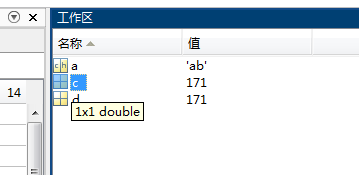1、十六进制转成十进制hex2dec.这个函数转换得到的是double类型的十进制;所以要转成uint8类型
cc=hex2dec(‘5’)
cc=5
cc=hex2dec(‘A’)
cc=10
cc=hex2dec(‘a’)
cc=10
cc=hex2dec(‘a1’)
cc=161
161=10*16+1

matlab1C0_16">2、matlab的数组,从下标1开始;而不是C语言的0开始。
3、测试
a(1,1)=‘a’;
a(1,2)=‘b’;
c=hex2dec(a);
d=uint8©;
上面例子中。c=171,是double类型。因为hex2dec函数,返回值是double;
d=171,是uint8类型,已经转换了一下。


4、if----else使用.注意end。
不等于 ~=
大于等于>=,小于等于<=
%from=5,to=8
if size([from:to],2) ~= 4
disp('error: too few arguments')
elseif size(input,1) <= to
% float(A,7,10);
disp('error: message error')
else
for i = [1:2:8]
tmp(1,i) = input(to,1);
tmp(1,i+1) = input(to,2);
to = to - 1;
end
val = typecast(uint32(hex2dec(tmp)),'single');
end
5、
switch case的使用。没有冒号。没有break,用otherwise
switch msg_id
case 12
if int16(crc(A,1,165)) == get_crc(A)
pwm(i,1) = int16_t(A,11,12);
rpm(i,1) = float(A,7,10);
disp(['pwm: ',num2str(pwm(i,1)),', ' ...
'rpm: ', num2str(rpm(i,1))])
h.XData = pwm;
h.YData = rpm;
drawnow
i = i + 1;
end
case 13
if int16(crc(A,1,196)) == get_crc(A)
if uint8_t(A,7) == 1
fclose(t)
break
end
end
otherwise
fclose(t)
break
end
6/ uint8_t## 标题## 标题函## 标题数,自己编写。
function [ val ] = uint8_t(input, to)
% float.m
% decode from hex to float
% input - mavlink message from udp
% to - end byte index
if size(input,1) <= to
disp('error')
else
temp(1,1) = input(to,1);
temp(1,2) = input(to,2);
val = uint8(hex2dec(temp));
end
end
%example: msg_id = uint8_t(A,6);
matlab_100">7/matlab开头
clc
clear
close all
8、int16_t(input, from, to)、、 pwm(i,1) = int16_t(A,11,12);
function [ val ] = int16_t(input, from, to)
% float.m
% decode from hex to float
% input - mavlink message from udp
% from - start byte index
% to - end byte index
if size([from:to],2) ~= 2
disp('error: too few arguments')
elseif size(input,1) <= to
disp('error: message error')
else
for i = [1:2:4]
tmp(1,i) = input(to,1);
tmp(1,i+1) = input(to,2);
to = to - 1;
end
val = typecast(uint16(hex2dec(tmp)),'int16');
end
end
9、 float(input, from, to)、、、 rpm(i,1) = float(A,7,10);
function [ val ] = float(input, from, to)
% float.m
% decode from hex to float
% input - mavlink message from udp
% from - start byte index
% to - end byte index
%from=5,to=8
if size([from:to],2) ~= 4
disp('error: too few arguments')
elseif size(input,1) <= to
% float(A,7,10);
disp('error: message error')
else
for i = [1:2:8]
tmp(1,i) = input(to,1);
tmp(1,i+1) = input(to,2);
to = to - 1;
end
val = typecast(uint32(hex2dec(tmp)),'single');
end
end
10、 time(i,1) = uint32_t(A,7,10);
function [ val ] = float(input, from, to)
% float.m
% decode from hex to float
% input - mavlink message from udp
% from - start byte index
% to - end byte index
if size([from:to],2) ~= 4
disp('error: too few arguments')
elseif size(input,1) <= to
disp('error: message error')
else
for i = [1:2:8]
tmp(1,i) = input(to,1);
tmp(1,i+1) = input(to,2);
to = to - 1;
end
val = typecast(uint32(hex2dec(tmp)),'uint32');
end
end
11、画图。曲线
clc
if exist('pwm')
clear pwm
end
if exist('rpm')
clear rpm
end
t = udp('127.0.0.1', 80, 'LocalPort', 14550);
t.InputBufferSize = 89120;
fopen(t)
pwm = 0;
rpm = 0;
h = plot(pwm,rpm,'r.');
i = 1;
while 1
tic %开始计时间
A = dec2hex(fread(t));%将读到的数据,从10进制转变成16进制
if ~isempty(A) %如果A不是空的
msg_id = uint8_t(A,6);
switch msg_id
case 12
if int16(crc(A,1,165)) == get_crc(A)
pwm(i,1) = int16_t(A,11,12);
rpm(i,1) = float(A,7,10);
disp(['pwm: ',num2str(pwm(i,1)),', ' ...
'rpm: ', num2str(rpm(i,1))])
h.XData = pwm;
h.YData = rpm;
drawnow
i = i + 1;
end
case 13
if int16(crc(A,1,196)) == get_crc(A)
if uint8_t(A,7) == 1
fclose(t)
break
end
end
otherwise
fclose(t)
break
end
end
freq(i,1) = 1/toc;
end
fclose(t)
绘制换行,三个省略点
disp(['time: ',num2str(time(i,1)),', ' ...
'gx: ',num2str(gx(i,1)),', ' ...
'gy: ', num2str(gy(i,1)),', ' ...
'gz: ', num2str(gz(i,1)),', ' ...
'ax: ', num2str(ax(i,1)),', ' ...
'ay: ', num2str(ay(i,1)),', ' ...
'az: ', num2str(az(i,1))])


